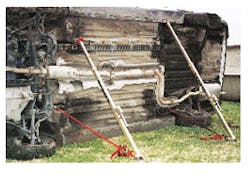Vehicle Stabilization - Part 2
Understand the principle of "tensioned" buttress stabilization.
Subject: Vehicle Stabilization, Part 2
Topic: "Tensioned" Buttress Stabilization
Objective: Understand tensioned buttress vehicle stabilization systems
Task: Review the operation of two vehicle stabilization systems which employ tensioning in their application
As fire/rescue personnel be-come more familiar with tensioned buttress stabilization for vehicle rescue, additional manufacturers are developing new stabilization systems. This article will feature two new systems and explain their operation. Both systems, designed primarily for stabilization of passenger cars and light trucks, are used in conjunction with cribbing and employ the tensioned buttress concept.
The CRUTCH
A Florida extrication team helped design the CRUTCH vehicle stabilization system to reduce the time required to stabilize vehicles on their sides, roofs or on top of other objects. One CRUTCH is positioned on the roof side of the rollover vehicle, preferably near the firewall area. A second CRUTCH is located along the undercarriage, opposite and across from the first unit. Used in pairs, each CRUTCH consists of 11’2-inch-square steel tubing that adjusts from 48 inches to a fully extended length of 76 inches. As the upper tube telescopes out to the required length, it is pinned in place. The steel tubing is plated with "yellow zinc," an application proven to outlast paint coatings. Adjusting the length allows the operator to attain the optimum angle of 75 degrees, a most important item to consider when placing tensioned stabilization equipment in position. This angle is good to keep the base from slipping out should the nylon strap be inadvertently cut. Seventy-five degrees is easy for firefighters to reference because it is the typical climbing angle for a ladder.
The upper end of the CRUTCH tubing accepts a two-headed accessory called the end-tool. On one side of the end-tool is a rod that fits into holes or corner areas. On the other side of the end-tool is a flat insertion plate end that fits into slender areas such as the hood, trunk and fender seams.
Each CRUTCH has an attached base plate with a non-skid surface secured to it along with a ratchet device, one inch-wide webbing and steel hooks. The metal hooks on the web are attached to firm points low along the vehicle. It is this ratchet and straps that tension the CRUTCH units? final position. To support an object such as a pole that has fallen on a vehicle, two CRUTCH tools can be formed into an "X" with the top of the X used to capture the pole. The base plates are held together with the ratchet straps. By detaching the unit?s carrying handle, itself a steel threaded rod with a square collar, rescuers can convert the CRUTCH into a lolly column for supporting loads up to 750 pounds at other types of rescue incidents.
Res-Q-Jack
The Res-Q-Jack system differs from the CRUTCH in that it actually employs a jacking device and two Companion Jacks to create three tensioned stabilization points around a vehicle on its edge. The Companion Jacks consist of telescopic perforated steel tubes which allow for height adjustment in two-inch increments.
The upper end of each Compan-ion Jack is pointed, allowing it to be braced against a strong point on the roof side of the vehicle. Attached at the base plates area pair of two-inch-wide nylon straps, each with an aluminum cam buckle and a metal hook. Once all components are in place, one simple pull on the strap releases the cam buckle and tensions the stabilization system. The inside straps of each Companion Jack can be joined to further resist torsional movement of the vehicle.
The Jacking Post, which is positioned on the opposite side from the Companion Jacks, consists of a 78-inch fixed-length steel tube with a swivel base plate, two straps and cam buckles. In use, the actual Res-Q-Jack unit slides onto this post and once in place, is cranked up or down. The jack has a unique mechanism which locks itself to the steel upright under load. When unloaded, the mechanism releases and the jack slides up or down to the required position. The rolled metal lip of the Res-Q-Jack is designed to catch the vehicle?s rocker channel edge. Turning the side wind jack handle loads the jack against the vehicle.
With a vehicle completely on its roof, cribbing and the Res-Q-Jack can be used together for vehicle stabilization. A rescue strap or chain is hooked at each end to a secure point at the rear or front of the vehicle. Cribbing is placed at the opposite end from the Res-Q-Jack. The center of the strap or chain is then placed over the lip of the Res-Q-Jack and the adjustable straps secured low on the vehicle. Although the Res-Q-Jack is not for hoisting loads, as the handle is operated, the jack will tighten to stabilize and relieve the load on the overturned vehicle.
CRUTCH Fact Sheet
Alpha Rescue Products Inc. Clearwater, FL 727-786-9648 [email protected] |
Res-Q-Jack Fact Sheet Companion Jack
Jacking Post
Jacking Unit Jack: side wind-type, handle permanently attached
Cepco Tool Co. PO Box 153 Spencer, NY 14883 800-466-9626 |
Ron Moore, a Firehouse contributing editor, is a battalion chief and the training officer for the McKinney, TX, Fire Department. He also authors a monthly online article in the Firehouse.com ?MembersZone? and serves as the Forum Moderator for the extrication section of the Firehouse.com website. Moore can be contacted directly at [email protected].
